Assessment 1: Aging Process Discussion and Nursing Care Analysis
VerifiedAdded on 2023/06/10
|8
|1978
|378
Essay
AI Summary
This essay analyzes a discussion with an older person, exploring their experiences of the aging process and the challenges they face. The introduction highlights the importance of understanding the hardships of older adults to improve geriatric nursing care. The critical reflection section discusses key insights from the discussion, such as the presence of chronic diseases, low mobility, and the need for empathetic and patient-centered care. The critical review and discussion delve into specific issues like falls and immobility, identifying contributing factors such as polypharmacy, vision impairment, Alzheimer's disease, hemiparesis, and osteoarthritis. The essay examines the impact of immobility on older adults, including malnutrition, pressure ulcers, depression, orthostatic hypertension, and deep vein thrombosis. The conclusion emphasizes the rewarding yet challenging nature of geriatric nursing, stressing the importance of compassion, patience, and the emotional bond between nurses and patients to support the well-being and independence of older adults. The assignment is based on an assessment for a Nursing degree at the University of Technology, Sydney, focusing on providing the best possible quality of life for older people.
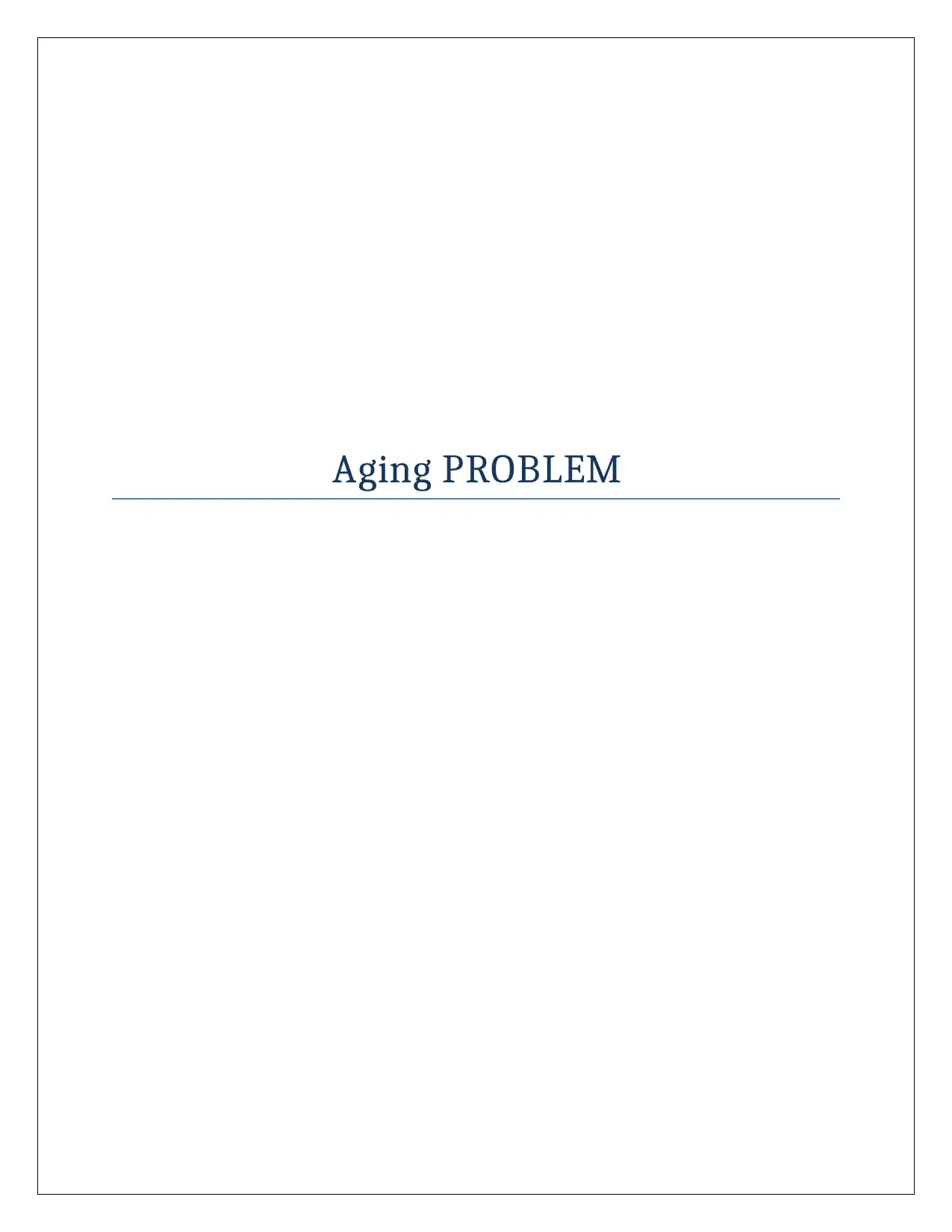
Aging PROBLEM
Paraphrase This Document
Need a fresh take? Get an instant paraphrase of this document with our AI Paraphraser
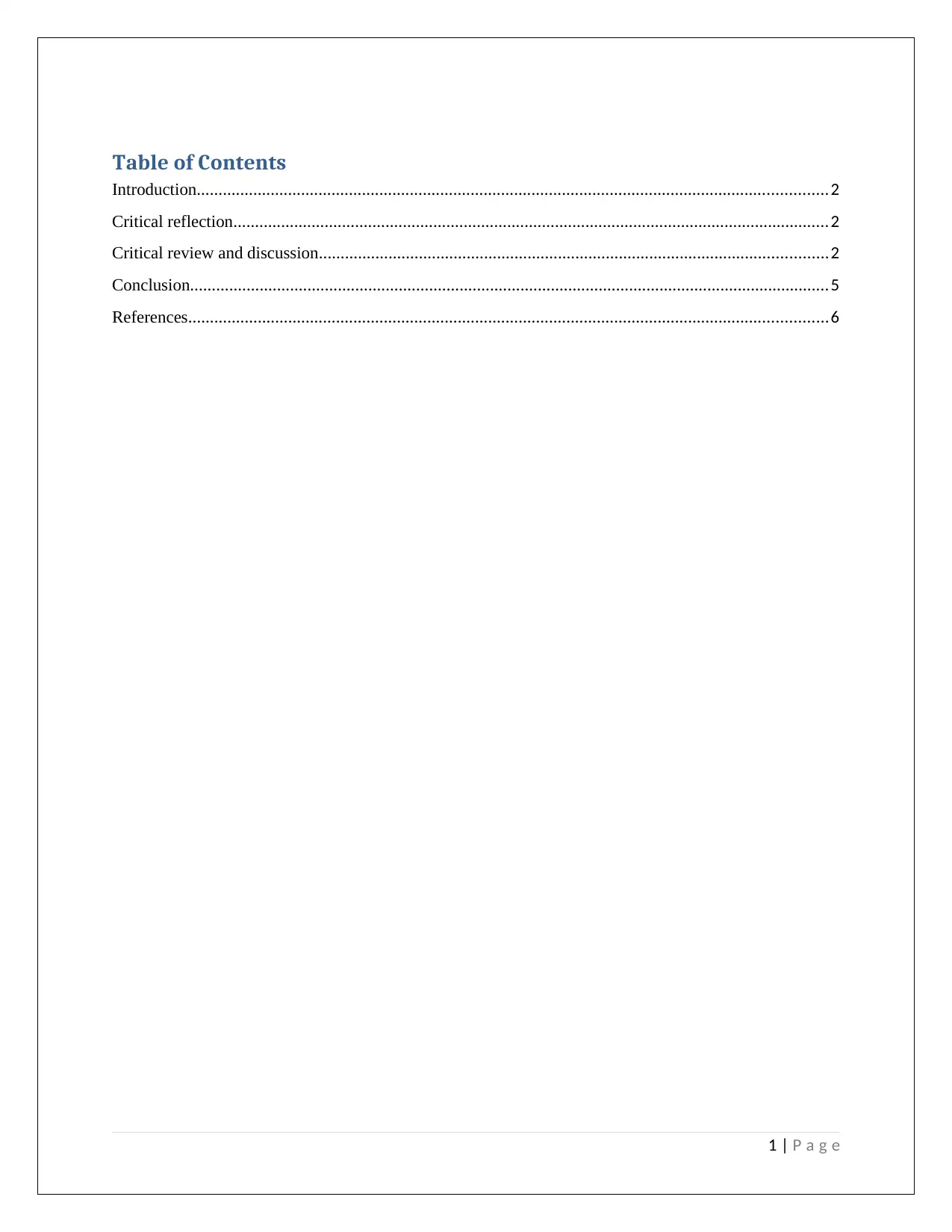
Table of Contents
Introduction.................................................................................................................................................2
Critical reflection.........................................................................................................................................2
Critical review and discussion.....................................................................................................................2
Conclusion...................................................................................................................................................5
References...................................................................................................................................................6
1 | P a g e
Introduction.................................................................................................................................................2
Critical reflection.........................................................................................................................................2
Critical review and discussion.....................................................................................................................2
Conclusion...................................................................................................................................................5
References...................................................................................................................................................6
1 | P a g e
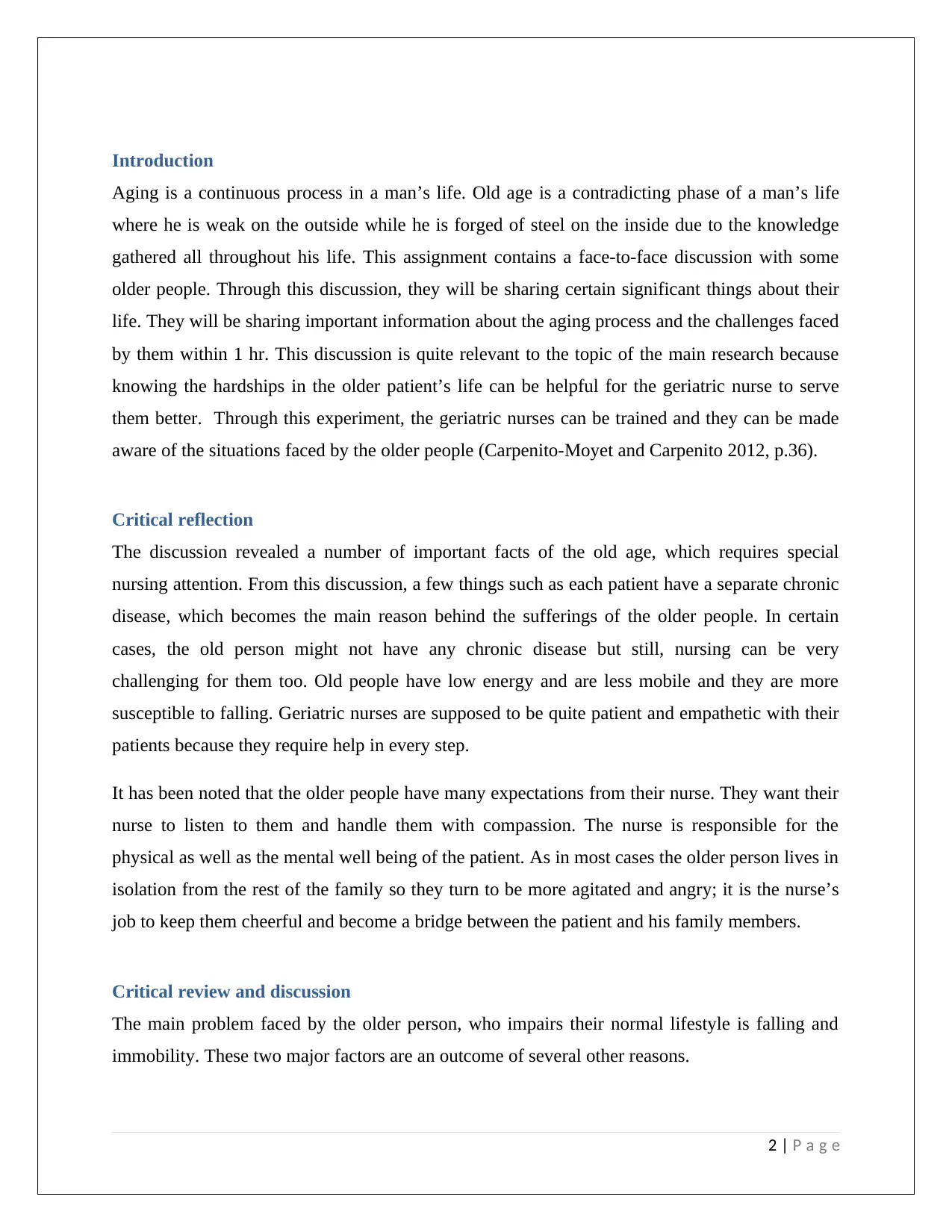
Introduction
Aging is a continuous process in a man’s life. Old age is a contradicting phase of a man’s life
where he is weak on the outside while he is forged of steel on the inside due to the knowledge
gathered all throughout his life. This assignment contains a face-to-face discussion with some
older people. Through this discussion, they will be sharing certain significant things about their
life. They will be sharing important information about the aging process and the challenges faced
by them within 1 hr. This discussion is quite relevant to the topic of the main research because
knowing the hardships in the older patient’s life can be helpful for the geriatric nurse to serve
them better. Through this experiment, the geriatric nurses can be trained and they can be made
aware of the situations faced by the older people (Carpenito-Moyet and Carpenito 2012, p.36).
Critical reflection
The discussion revealed a number of important facts of the old age, which requires special
nursing attention. From this discussion, a few things such as each patient have a separate chronic
disease, which becomes the main reason behind the sufferings of the older people. In certain
cases, the old person might not have any chronic disease but still, nursing can be very
challenging for them too. Old people have low energy and are less mobile and they are more
susceptible to falling. Geriatric nurses are supposed to be quite patient and empathetic with their
patients because they require help in every step.
It has been noted that the older people have many expectations from their nurse. They want their
nurse to listen to them and handle them with compassion. The nurse is responsible for the
physical as well as the mental well being of the patient. As in most cases the older person lives in
isolation from the rest of the family so they turn to be more agitated and angry; it is the nurse’s
job to keep them cheerful and become a bridge between the patient and his family members.
Critical review and discussion
The main problem faced by the older person, who impairs their normal lifestyle is falling and
immobility. These two major factors are an outcome of several other reasons.
2 | P a g e
Aging is a continuous process in a man’s life. Old age is a contradicting phase of a man’s life
where he is weak on the outside while he is forged of steel on the inside due to the knowledge
gathered all throughout his life. This assignment contains a face-to-face discussion with some
older people. Through this discussion, they will be sharing certain significant things about their
life. They will be sharing important information about the aging process and the challenges faced
by them within 1 hr. This discussion is quite relevant to the topic of the main research because
knowing the hardships in the older patient’s life can be helpful for the geriatric nurse to serve
them better. Through this experiment, the geriatric nurses can be trained and they can be made
aware of the situations faced by the older people (Carpenito-Moyet and Carpenito 2012, p.36).
Critical reflection
The discussion revealed a number of important facts of the old age, which requires special
nursing attention. From this discussion, a few things such as each patient have a separate chronic
disease, which becomes the main reason behind the sufferings of the older people. In certain
cases, the old person might not have any chronic disease but still, nursing can be very
challenging for them too. Old people have low energy and are less mobile and they are more
susceptible to falling. Geriatric nurses are supposed to be quite patient and empathetic with their
patients because they require help in every step.
It has been noted that the older people have many expectations from their nurse. They want their
nurse to listen to them and handle them with compassion. The nurse is responsible for the
physical as well as the mental well being of the patient. As in most cases the older person lives in
isolation from the rest of the family so they turn to be more agitated and angry; it is the nurse’s
job to keep them cheerful and become a bridge between the patient and his family members.
Critical review and discussion
The main problem faced by the older person, who impairs their normal lifestyle is falling and
immobility. These two major factors are an outcome of several other reasons.
2 | P a g e
⊘ This is a preview!⊘
Do you want full access?
Subscribe today to unlock all pages.

Trusted by 1+ million students worldwide
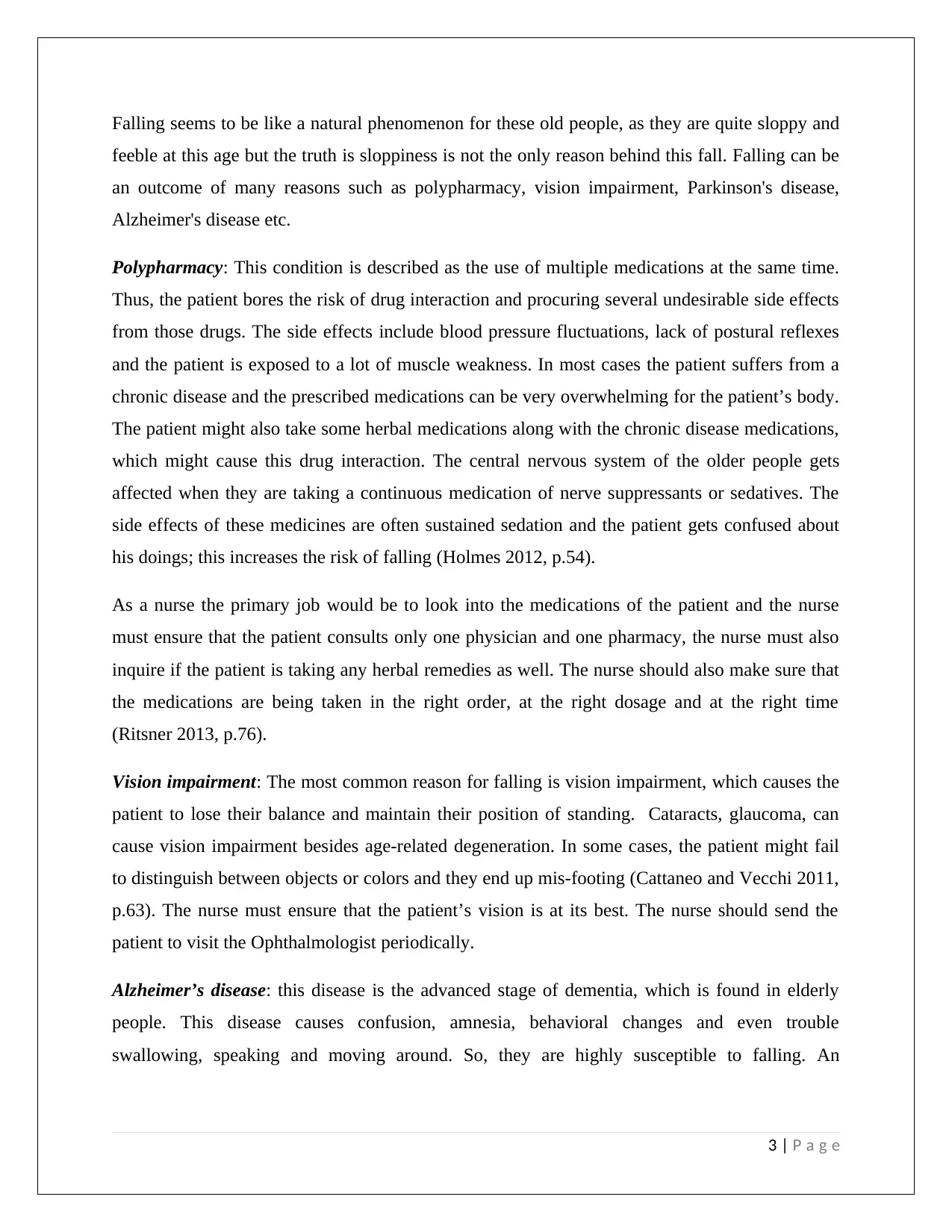
Falling seems to be like a natural phenomenon for these old people, as they are quite sloppy and
feeble at this age but the truth is sloppiness is not the only reason behind this fall. Falling can be
an outcome of many reasons such as polypharmacy, vision impairment, Parkinson's disease,
Alzheimer's disease etc.
Polypharmacy: This condition is described as the use of multiple medications at the same time.
Thus, the patient bores the risk of drug interaction and procuring several undesirable side effects
from those drugs. The side effects include blood pressure fluctuations, lack of postural reflexes
and the patient is exposed to a lot of muscle weakness. In most cases the patient suffers from a
chronic disease and the prescribed medications can be very overwhelming for the patient’s body.
The patient might also take some herbal medications along with the chronic disease medications,
which might cause this drug interaction. The central nervous system of the older people gets
affected when they are taking a continuous medication of nerve suppressants or sedatives. The
side effects of these medicines are often sustained sedation and the patient gets confused about
his doings; this increases the risk of falling (Holmes 2012, p.54).
As a nurse the primary job would be to look into the medications of the patient and the nurse
must ensure that the patient consults only one physician and one pharmacy, the nurse must also
inquire if the patient is taking any herbal remedies as well. The nurse should also make sure that
the medications are being taken in the right order, at the right dosage and at the right time
(Ritsner 2013, p.76).
Vision impairment: The most common reason for falling is vision impairment, which causes the
patient to lose their balance and maintain their position of standing. Cataracts, glaucoma, can
cause vision impairment besides age-related degeneration. In some cases, the patient might fail
to distinguish between objects or colors and they end up mis-footing (Cattaneo and Vecchi 2011,
p.63). The nurse must ensure that the patient’s vision is at its best. The nurse should send the
patient to visit the Ophthalmologist periodically.
Alzheimer’s disease: this disease is the advanced stage of dementia, which is found in elderly
people. This disease causes confusion, amnesia, behavioral changes and even trouble
swallowing, speaking and moving around. So, they are highly susceptible to falling. An
3 | P a g e
feeble at this age but the truth is sloppiness is not the only reason behind this fall. Falling can be
an outcome of many reasons such as polypharmacy, vision impairment, Parkinson's disease,
Alzheimer's disease etc.
Polypharmacy: This condition is described as the use of multiple medications at the same time.
Thus, the patient bores the risk of drug interaction and procuring several undesirable side effects
from those drugs. The side effects include blood pressure fluctuations, lack of postural reflexes
and the patient is exposed to a lot of muscle weakness. In most cases the patient suffers from a
chronic disease and the prescribed medications can be very overwhelming for the patient’s body.
The patient might also take some herbal medications along with the chronic disease medications,
which might cause this drug interaction. The central nervous system of the older people gets
affected when they are taking a continuous medication of nerve suppressants or sedatives. The
side effects of these medicines are often sustained sedation and the patient gets confused about
his doings; this increases the risk of falling (Holmes 2012, p.54).
As a nurse the primary job would be to look into the medications of the patient and the nurse
must ensure that the patient consults only one physician and one pharmacy, the nurse must also
inquire if the patient is taking any herbal remedies as well. The nurse should also make sure that
the medications are being taken in the right order, at the right dosage and at the right time
(Ritsner 2013, p.76).
Vision impairment: The most common reason for falling is vision impairment, which causes the
patient to lose their balance and maintain their position of standing. Cataracts, glaucoma, can
cause vision impairment besides age-related degeneration. In some cases, the patient might fail
to distinguish between objects or colors and they end up mis-footing (Cattaneo and Vecchi 2011,
p.63). The nurse must ensure that the patient’s vision is at its best. The nurse should send the
patient to visit the Ophthalmologist periodically.
Alzheimer’s disease: this disease is the advanced stage of dementia, which is found in elderly
people. This disease causes confusion, amnesia, behavioral changes and even trouble
swallowing, speaking and moving around. So, they are highly susceptible to falling. An
3 | P a g e
Paraphrase This Document
Need a fresh take? Get an instant paraphrase of this document with our AI Paraphraser
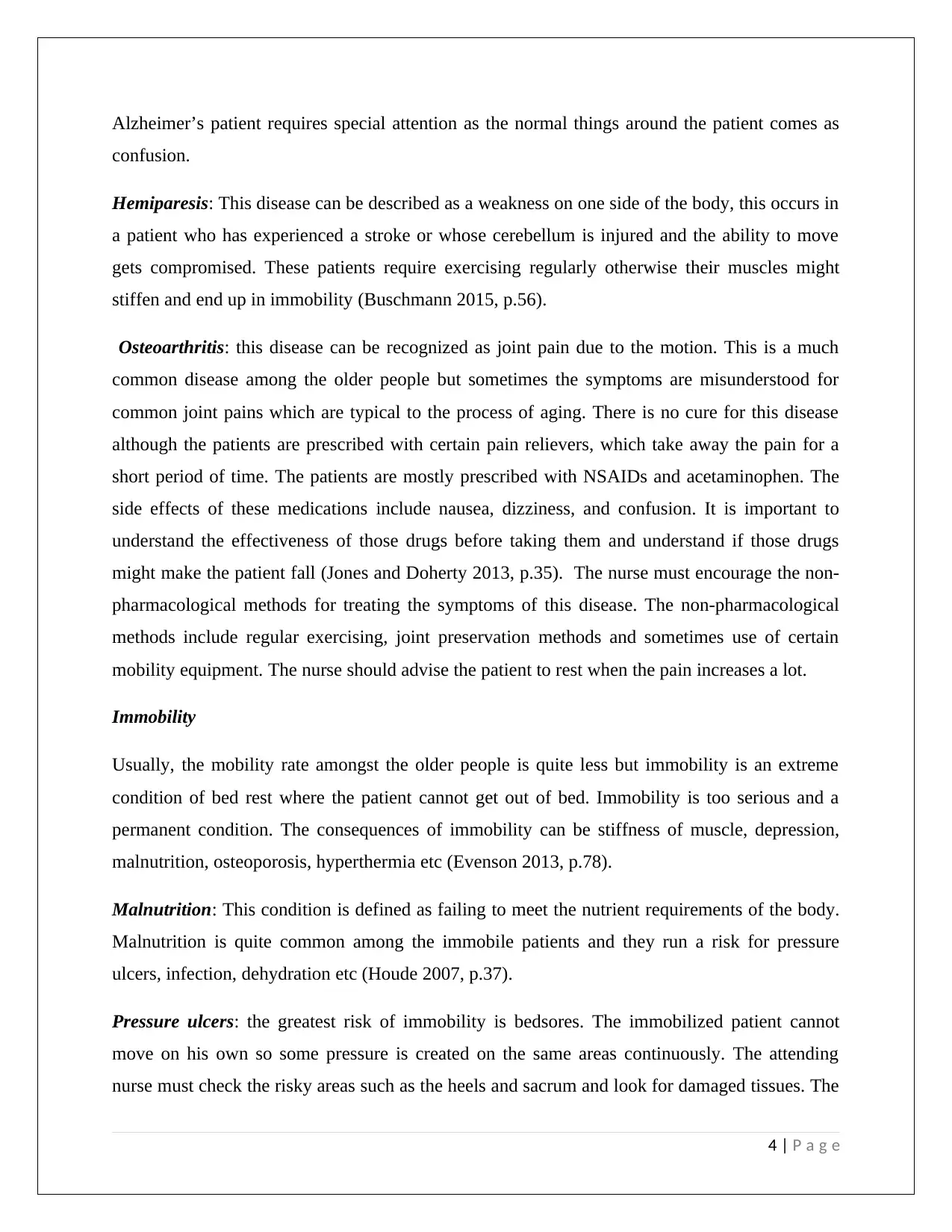
Alzheimer’s patient requires special attention as the normal things around the patient comes as
confusion.
Hemiparesis: This disease can be described as a weakness on one side of the body, this occurs in
a patient who has experienced a stroke or whose cerebellum is injured and the ability to move
gets compromised. These patients require exercising regularly otherwise their muscles might
stiffen and end up in immobility (Buschmann 2015, p.56).
Osteoarthritis: this disease can be recognized as joint pain due to the motion. This is a much
common disease among the older people but sometimes the symptoms are misunderstood for
common joint pains which are typical to the process of aging. There is no cure for this disease
although the patients are prescribed with certain pain relievers, which take away the pain for a
short period of time. The patients are mostly prescribed with NSAIDs and acetaminophen. The
side effects of these medications include nausea, dizziness, and confusion. It is important to
understand the effectiveness of those drugs before taking them and understand if those drugs
might make the patient fall (Jones and Doherty 2013, p.35). The nurse must encourage the non-
pharmacological methods for treating the symptoms of this disease. The non-pharmacological
methods include regular exercising, joint preservation methods and sometimes use of certain
mobility equipment. The nurse should advise the patient to rest when the pain increases a lot.
Immobility
Usually, the mobility rate amongst the older people is quite less but immobility is an extreme
condition of bed rest where the patient cannot get out of bed. Immobility is too serious and a
permanent condition. The consequences of immobility can be stiffness of muscle, depression,
malnutrition, osteoporosis, hyperthermia etc (Evenson 2013, p.78).
Malnutrition: This condition is defined as failing to meet the nutrient requirements of the body.
Malnutrition is quite common among the immobile patients and they run a risk for pressure
ulcers, infection, dehydration etc (Houde 2007, p.37).
Pressure ulcers: the greatest risk of immobility is bedsores. The immobilized patient cannot
move on his own so some pressure is created on the same areas continuously. The attending
nurse must check the risky areas such as the heels and sacrum and look for damaged tissues. The
4 | P a g e
confusion.
Hemiparesis: This disease can be described as a weakness on one side of the body, this occurs in
a patient who has experienced a stroke or whose cerebellum is injured and the ability to move
gets compromised. These patients require exercising regularly otherwise their muscles might
stiffen and end up in immobility (Buschmann 2015, p.56).
Osteoarthritis: this disease can be recognized as joint pain due to the motion. This is a much
common disease among the older people but sometimes the symptoms are misunderstood for
common joint pains which are typical to the process of aging. There is no cure for this disease
although the patients are prescribed with certain pain relievers, which take away the pain for a
short period of time. The patients are mostly prescribed with NSAIDs and acetaminophen. The
side effects of these medications include nausea, dizziness, and confusion. It is important to
understand the effectiveness of those drugs before taking them and understand if those drugs
might make the patient fall (Jones and Doherty 2013, p.35). The nurse must encourage the non-
pharmacological methods for treating the symptoms of this disease. The non-pharmacological
methods include regular exercising, joint preservation methods and sometimes use of certain
mobility equipment. The nurse should advise the patient to rest when the pain increases a lot.
Immobility
Usually, the mobility rate amongst the older people is quite less but immobility is an extreme
condition of bed rest where the patient cannot get out of bed. Immobility is too serious and a
permanent condition. The consequences of immobility can be stiffness of muscle, depression,
malnutrition, osteoporosis, hyperthermia etc (Evenson 2013, p.78).
Malnutrition: This condition is defined as failing to meet the nutrient requirements of the body.
Malnutrition is quite common among the immobile patients and they run a risk for pressure
ulcers, infection, dehydration etc (Houde 2007, p.37).
Pressure ulcers: the greatest risk of immobility is bedsores. The immobilized patient cannot
move on his own so some pressure is created on the same areas continuously. The attending
nurse must check the risky areas such as the heels and sacrum and look for damaged tissues. The
4 | P a g e
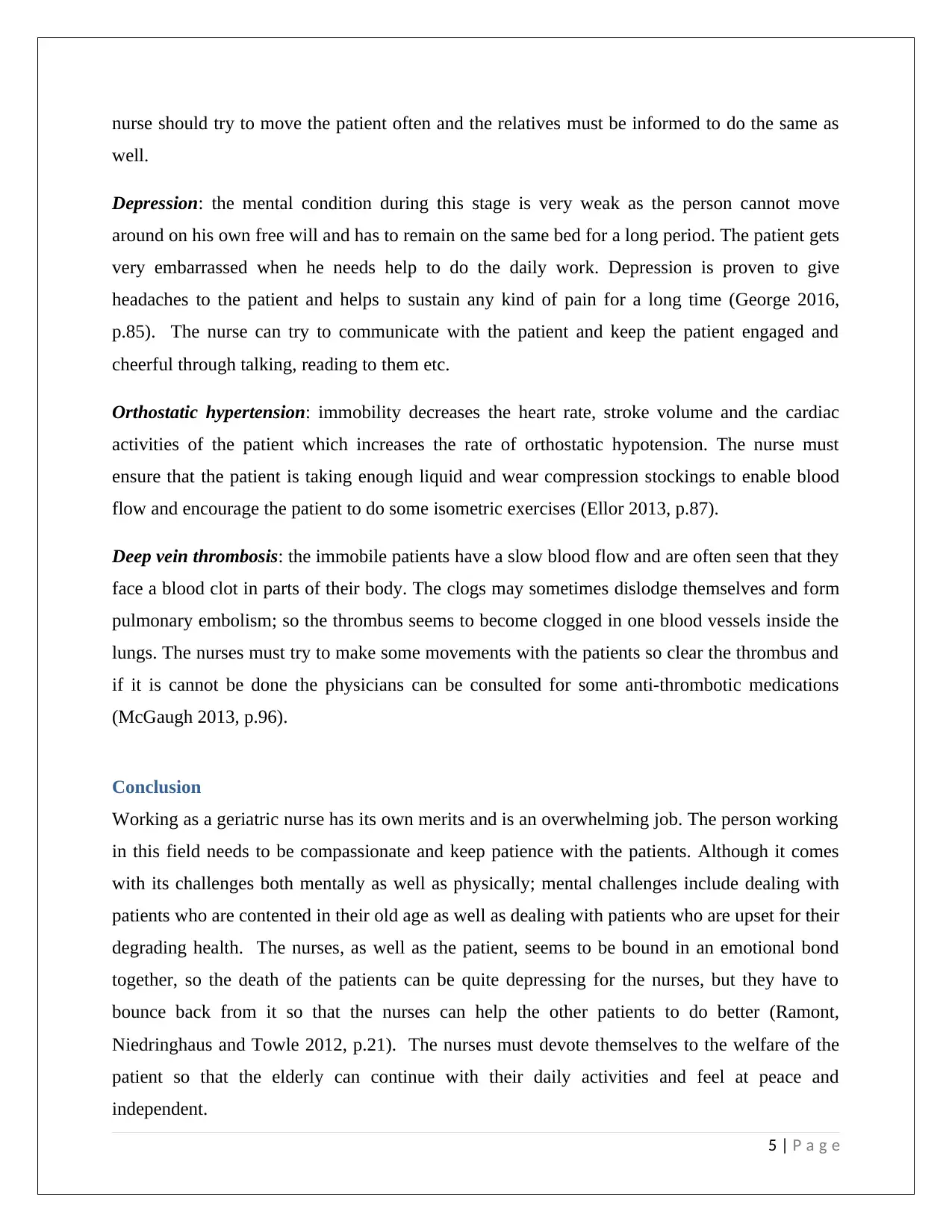
nurse should try to move the patient often and the relatives must be informed to do the same as
well.
Depression: the mental condition during this stage is very weak as the person cannot move
around on his own free will and has to remain on the same bed for a long period. The patient gets
very embarrassed when he needs help to do the daily work. Depression is proven to give
headaches to the patient and helps to sustain any kind of pain for a long time (George 2016,
p.85). The nurse can try to communicate with the patient and keep the patient engaged and
cheerful through talking, reading to them etc.
Orthostatic hypertension: immobility decreases the heart rate, stroke volume and the cardiac
activities of the patient which increases the rate of orthostatic hypotension. The nurse must
ensure that the patient is taking enough liquid and wear compression stockings to enable blood
flow and encourage the patient to do some isometric exercises (Ellor 2013, p.87).
Deep vein thrombosis: the immobile patients have a slow blood flow and are often seen that they
face a blood clot in parts of their body. The clogs may sometimes dislodge themselves and form
pulmonary embolism; so the thrombus seems to become clogged in one blood vessels inside the
lungs. The nurses must try to make some movements with the patients so clear the thrombus and
if it is cannot be done the physicians can be consulted for some anti-thrombotic medications
(McGaugh 2013, p.96).
Conclusion
Working as a geriatric nurse has its own merits and is an overwhelming job. The person working
in this field needs to be compassionate and keep patience with the patients. Although it comes
with its challenges both mentally as well as physically; mental challenges include dealing with
patients who are contented in their old age as well as dealing with patients who are upset for their
degrading health. The nurses, as well as the patient, seems to be bound in an emotional bond
together, so the death of the patients can be quite depressing for the nurses, but they have to
bounce back from it so that the nurses can help the other patients to do better (Ramont,
Niedringhaus and Towle 2012, p.21). The nurses must devote themselves to the welfare of the
patient so that the elderly can continue with their daily activities and feel at peace and
independent.
5 | P a g e
well.
Depression: the mental condition during this stage is very weak as the person cannot move
around on his own free will and has to remain on the same bed for a long period. The patient gets
very embarrassed when he needs help to do the daily work. Depression is proven to give
headaches to the patient and helps to sustain any kind of pain for a long time (George 2016,
p.85). The nurse can try to communicate with the patient and keep the patient engaged and
cheerful through talking, reading to them etc.
Orthostatic hypertension: immobility decreases the heart rate, stroke volume and the cardiac
activities of the patient which increases the rate of orthostatic hypotension. The nurse must
ensure that the patient is taking enough liquid and wear compression stockings to enable blood
flow and encourage the patient to do some isometric exercises (Ellor 2013, p.87).
Deep vein thrombosis: the immobile patients have a slow blood flow and are often seen that they
face a blood clot in parts of their body. The clogs may sometimes dislodge themselves and form
pulmonary embolism; so the thrombus seems to become clogged in one blood vessels inside the
lungs. The nurses must try to make some movements with the patients so clear the thrombus and
if it is cannot be done the physicians can be consulted for some anti-thrombotic medications
(McGaugh 2013, p.96).
Conclusion
Working as a geriatric nurse has its own merits and is an overwhelming job. The person working
in this field needs to be compassionate and keep patience with the patients. Although it comes
with its challenges both mentally as well as physically; mental challenges include dealing with
patients who are contented in their old age as well as dealing with patients who are upset for their
degrading health. The nurses, as well as the patient, seems to be bound in an emotional bond
together, so the death of the patients can be quite depressing for the nurses, but they have to
bounce back from it so that the nurses can help the other patients to do better (Ramont,
Niedringhaus and Towle 2012, p.21). The nurses must devote themselves to the welfare of the
patient so that the elderly can continue with their daily activities and feel at peace and
independent.
5 | P a g e
⊘ This is a preview!⊘
Do you want full access?
Subscribe today to unlock all pages.

Trusted by 1+ million students worldwide
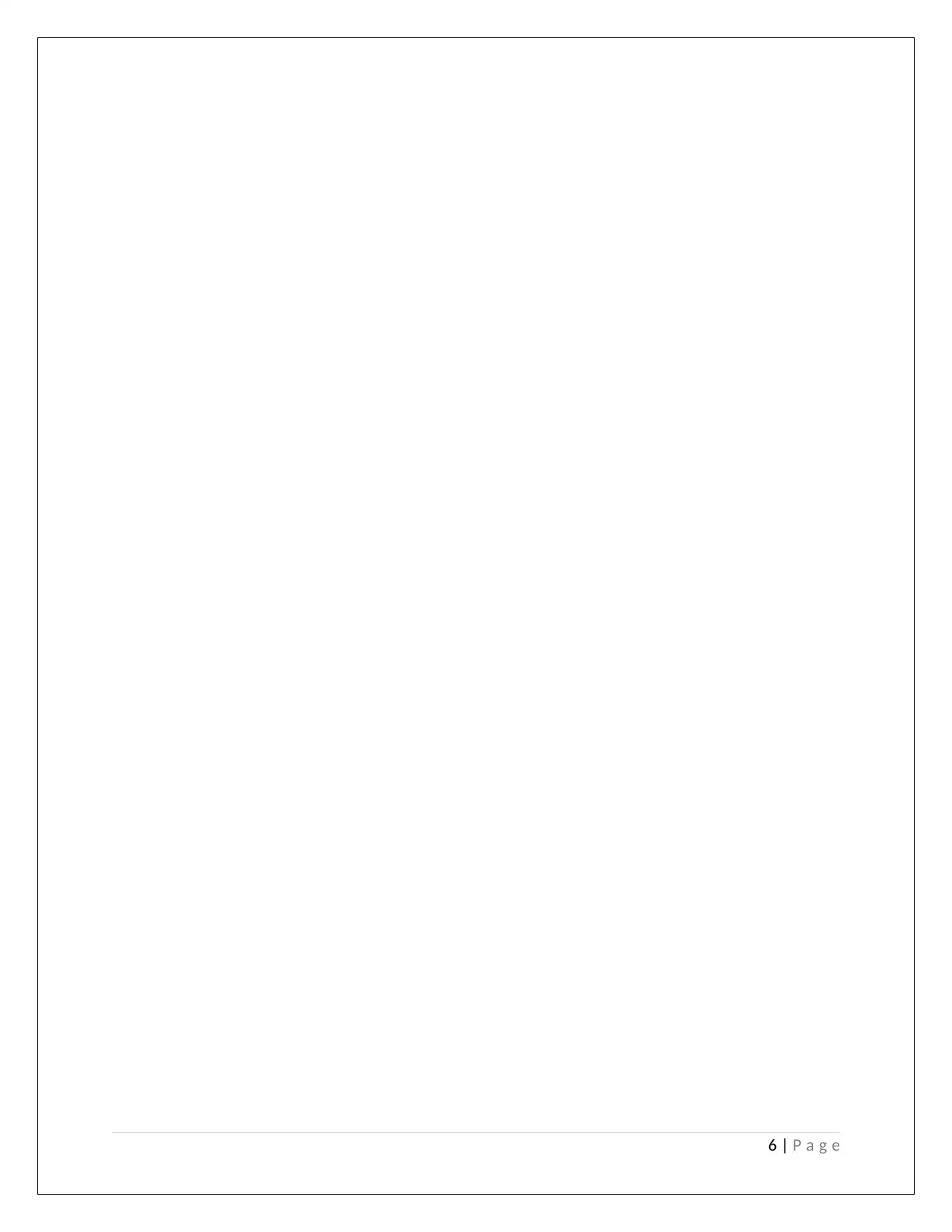
6 | P a g e
Paraphrase This Document
Need a fresh take? Get an instant paraphrase of this document with our AI Paraphraser
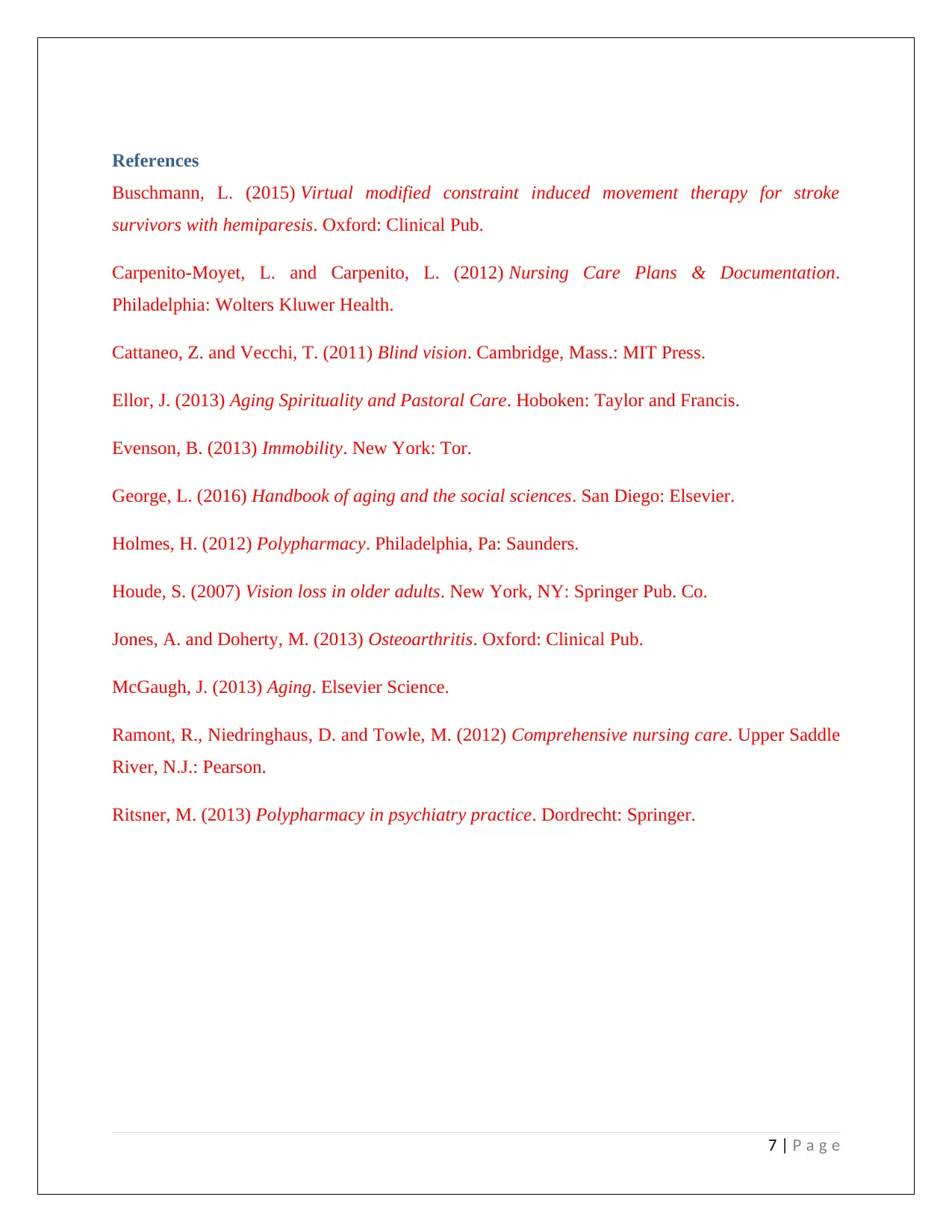
References
Buschmann, L. (2015) Virtual modified constraint induced movement therapy for stroke
survivors with hemiparesis. Oxford: Clinical Pub.
Carpenito-Moyet, L. and Carpenito, L. (2012) Nursing Care Plans & Documentation.
Philadelphia: Wolters Kluwer Health.
Cattaneo, Z. and Vecchi, T. (2011) Blind vision. Cambridge, Mass.: MIT Press.
Ellor, J. (2013) Aging Spirituality and Pastoral Care. Hoboken: Taylor and Francis.
Evenson, B. (2013) Immobility. New York: Tor.
George, L. (2016) Handbook of aging and the social sciences. San Diego: Elsevier.
Holmes, H. (2012) Polypharmacy. Philadelphia, Pa: Saunders.
Houde, S. (2007) Vision loss in older adults. New York, NY: Springer Pub. Co.
Jones, A. and Doherty, M. (2013) Osteoarthritis. Oxford: Clinical Pub.
McGaugh, J. (2013) Aging. Elsevier Science.
Ramont, R., Niedringhaus, D. and Towle, M. (2012) Comprehensive nursing care. Upper Saddle
River, N.J.: Pearson.
Ritsner, M. (2013) Polypharmacy in psychiatry practice. Dordrecht: Springer.
7 | P a g e
Buschmann, L. (2015) Virtual modified constraint induced movement therapy for stroke
survivors with hemiparesis. Oxford: Clinical Pub.
Carpenito-Moyet, L. and Carpenito, L. (2012) Nursing Care Plans & Documentation.
Philadelphia: Wolters Kluwer Health.
Cattaneo, Z. and Vecchi, T. (2011) Blind vision. Cambridge, Mass.: MIT Press.
Ellor, J. (2013) Aging Spirituality and Pastoral Care. Hoboken: Taylor and Francis.
Evenson, B. (2013) Immobility. New York: Tor.
George, L. (2016) Handbook of aging and the social sciences. San Diego: Elsevier.
Holmes, H. (2012) Polypharmacy. Philadelphia, Pa: Saunders.
Houde, S. (2007) Vision loss in older adults. New York, NY: Springer Pub. Co.
Jones, A. and Doherty, M. (2013) Osteoarthritis. Oxford: Clinical Pub.
McGaugh, J. (2013) Aging. Elsevier Science.
Ramont, R., Niedringhaus, D. and Towle, M. (2012) Comprehensive nursing care. Upper Saddle
River, N.J.: Pearson.
Ritsner, M. (2013) Polypharmacy in psychiatry practice. Dordrecht: Springer.
7 | P a g e
1 out of 8
Related Documents
Your All-in-One AI-Powered Toolkit for Academic Success.
+13062052269
info@desklib.com
Available 24*7 on WhatsApp / Email
![[object Object]](/_next/static/media/star-bottom.7253800d.svg)
Unlock your academic potential
Copyright © 2020–2026 A2Z Services. All Rights Reserved. Developed and managed by ZUCOL.





